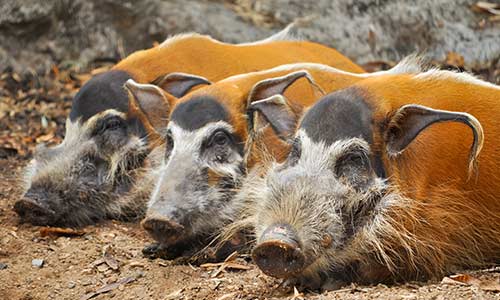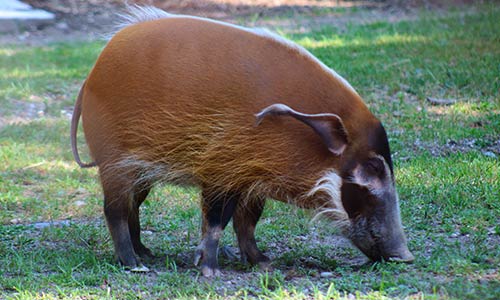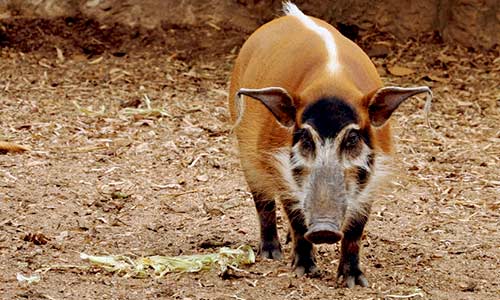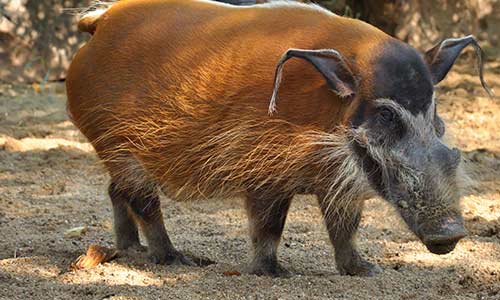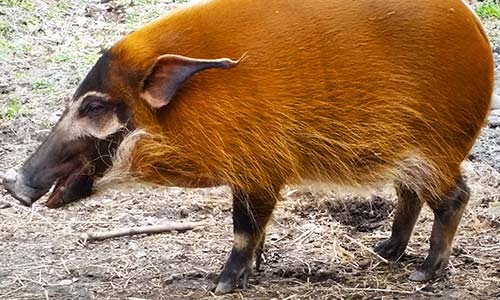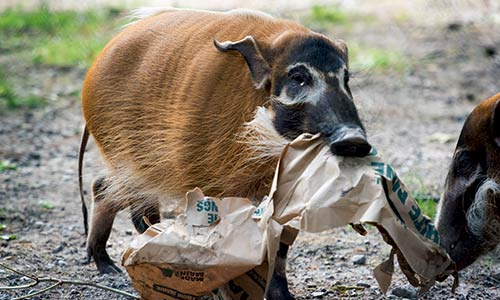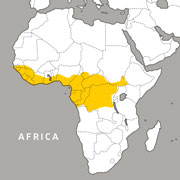Appearance:
The red river hog has coarse, rosy hair all over its body with a crest of white hair running along its spine. Its face and legs are dark brown or black, with a trim of white on its cheeks and around its eyes. Both males and females have tusks. Their long snouts have lengthwise ridges and warts in males, often hidden by bushy facial hair. Red river hogs are most closely related to the eastern bush pig.
Size:
- Shoulder height: 2 - 3 feet
- Body length: 3 – 5 feet
- Tail length: 1 – 1.5 feet
- Weight: 99 – 264 pounds
Diet:
Grasses, roots, bulbs and fruits are the most common sources of food, although small mammals, reptiles, birds’ eggs and carrion may all be eaten.
Mating/Reproduction:
Red river hogs reach sexual maturity between 18 and 21 months of age. In the wild, breeding season begins in September and lasts through April. The peak season is during the wetter months between November and February. In the wild, drought conditions appear to have an affect on the number of females breeding. Births are between April and June.
Females make a nest, where they hide in the grass and vegetation. Male hogs give females a good amount of attention during the time of pregnancy, providing food and protection. After a gestation period of 120 days, hogs give birth to one to six piglets (four is the average). Piglets often stay in the tall grass with their mother until they’re ready to rejoin the group, which usually takes only a few days.
Behavior:
Red river hogs are social animals and often live in groups (sounders) ranging from two to 15 young females and one adult male. A typical group contains three to six individuals. Young males often create bachelor herds while they wait for their opportunity to become the dominant male of a group. Young females often remain in their natal group.
Red river hogs are most active at night and rest in self-excavated burrows in areas of dense vegetation during the day. They are fast runners and good swimmers. Hogs use their plow-like nose to root for food, and can cause considerable crop damage in a short period of time. They use their tusks to scrape tree trucks and also mark using foot, neck and pre-orbital glands. They have a strong flight response, but when cornered they're likely to attack. Red river hogs fight by pressing their foreheads together, butting heads, jabbing with their snouts, and whipping each other with their tails. They're a very dynamic and interactive species with a variety of vocalizations.
Habitat/Range:
Thickets, forests, savannas, swamps and steppes in West and Central Sub-Saharan Africa to Northern South Africa and Madagascar. A sounder (family group) may have a large home range of over 2 miles between resting and feeding areas. Hogs can also congregate around human villages.
There are two explanations for the radiation of red river hogs to Madagascar. One is that humans introduced the species. The second is that bush pigs floated to Madagascar on papyrus beds, which sometimes detach and float out to sea.
Median Life Expectancy:
15 years
Threats:
The red river hog's primary predators include humans, leopards, lions, spotted hyenas and pythons. Hog populations have been rising with the reduction of leopards. This is detrimental to humans because hogs can destroy crops, eat livestock, and carry diseases, such as African Swine Fever, which is fatal to domestic livestock.

